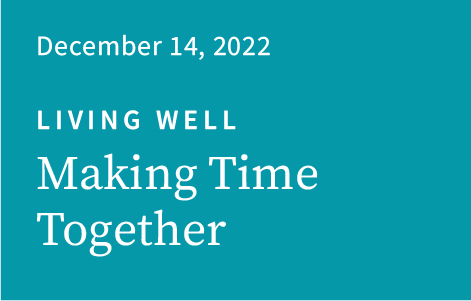Transcript
Making Time Together
Finding ways to stay socially connected can be challenging at any age—but it may be especially difficult for people living with dementia. The person’s cognitive impairment might make them feel uneasy in social situations. And negative stereotypes about people with dementia may cause friends to feel fearful or uncomfortable, and fade out of the picture.
Research shows that these hurdles are well worth surmounting. Meaningful social engagement has proven to be a key factor not only in maintaining brain health as we age, but also in slowing disease progression in people with dementia.
Keeping the person living with dementia socially engaged can be a burden for the loved one who often carries the brunt of caregiving responsibilities, and is already exhausted or overwhelmed by the emotional, physical, financial, and social strains of managing their loved one’s care. And the dementia component of caregiving can be especially weighty. Compared with non-dementia caregivers, dementia caregivers have higher levels of depression and anxiety, take more medications, and are generally in worse physical health. Half of dementia caregivers report feeling caught in a vicious cycle: The stresses of care contribute to health problems that in turn compromise their ability to provide care. And one in four reports financial hardship due to the costs of care.
In short, caregivers need a break.
Fortunately, there are some excellent social support programs available for people with dementia. Home care and adult day centers, for example, can be great resources for social interaction. However, community programs are few and far between, and agencies for home care may be cost-prohibitive because insurance coverage is scarce, nonexistent, or exorbitant. Also, people in early stages of dementia may only need social interaction—not the high level, and cost, of more advanced care such as day programs.
To help address these common issues, a program called Time Together was developed at the Penn Memory Center, where I am Executive Director.
Time Together trains college students to provide companionship and socially engage with older adults living with dementia—at a fraction of what an agency would charge. We conduct interviews to help make careful matches between the students and older adults. The trained students visit their matches in their homes or online for up to 10 hours a week of conversation, games, other recreation, or going for a walk.
Our evaluation of the program found several benefits of the Time Together model. The stimulation of connecting with people outside their typical social circle was, in itself, of value. Connecting with younger people with similar interests put participants in a mentorship role, which helped give these interactions a gratifying sense of purpose. They looked forward to sessions as a meaningful way to fill gaps in the day, especially during the pandemic. Through interviews and focus groups we got the sense that the relationships built through the program would have a lasting positive impact on everyone involved—the people living with dementia, their caregivers, and the students.
Here are some of their stories. Please note that some of the names have been changed to protect their privacy.
Kristina’s mother, Nancy, was diagnosed with primary progressive aphasia, which basically means she has difficulty with language or speech. Communicating through conversation is a frustrating challenge for her, and Kristina often felt stuck. When asked about her mom’s experience in Time Together, Kristina was enthusiastic. She says Nancy looks forward to the weekly meeting with her student match, Isabel, who shares a similar ethnic background. Isabel, recognizing Nancy’s difficulty speaking, reads to her and engages in storytelling activities. Their bond has been especially valuable during COVID, offering genuine connections through one-on-one interaction that would not have otherwise existed. Over the past year and a half, Nancy’s communication abilities have continued to decline—but her relationship with Isabel has blossomed. They have an easy relationship, free from the biases and worry that family members may carry. The weekly meetings also give Kristina a much appreciated break.
Paula’s husband, Stewart, has dementia. Since COVID, he’s been meeting with his student match, Jessica, over Zoom. When they first began, Paula would delight in Stewart’s attention to his appearance—combing his hair and getting dressed up for the Zoom meetings signaled that he was engaged. It is now the highlight of his week. The two of them hit it off well from the start. Over time, he has become a mentor to Jessica, giving her advice on her studies. Paula loves that the program gives her a reprieve from caregiving, but there are other personal benefits, too. She also enjoys talking with Jessica, and it makes her feel especially good to see how much her husband enjoys himself. She notices that it boosts his confidence because he feels like he’s making a difference in Jessica’s life.
Wes is living with mild-stage Alzheimer’s disease. He and his wife, Mary, have a home two hours from Philadelphia, so their student, Kate, has been meeting with them over Zoom. Mary says it’s been a lifesaver. They have much in common with Kate. Both Mary and Wes had careers working with people living with a disability, and Kate is pursuing a master’s in occupational therapy. Plus Kate and Wes graduated from the same university, and both are music lovers. Mary loves that the program opens opportunities for Wes to have meaningful interactions, and Wes says how much fun it is meeting with Kate. Another plus for Mary is that these social interactions happen in the comfort of their own home.
The benefits of Time Together also extend to the students. They note how much they appreciate the way learning firsthand about dementia and dementia care helps inform their career paths—sometimes it helps them improve their listening skills, and develop more patience.
Time Together is a working model for filling the gap when meaningful social engagement is hard to find. It can be replicated relatively easily by professionals or organizations that have access to colleges and universities. For the individual caregiver, Time Together might spark ideas for creating purposeful engagement for your loved one on your own. Just keep two things in mind.
First, don’t be afraid to ask people in your social network for help. Friends and family often really want to help—but they just don’t know how. Which brings me to the second point. Prepare for these meetings with simple activities that you can suggest the companion and your loved one do together. Take your cues from the stories I just told. Choose activities that are meaningful to your loved one and can be carried out by someone besides you. It can be as simple as enjoying a walk together or going out to lunch. Or engaging in shared interests like listening to music, visiting a museum, and painting or coloring together. These can be fun and relaxing ways to spend an hour, and be a backdrop for easy conversation. Meaningful time together can bring joy to both the person with dementia and the companion, as the Time Together program has shown.
Time Together has been virtual through the Penn Memory Center since the pandemic began, but we are returning to an in-person model this fall. If you are in the Philadelphia area and are interested in participating, you can contact me at felicia.greenfield@pennmedicine.upenn.edu.
Felicia Greenfield, MSW, LCSW
Executive Director
Penn Memory Center
www.pennmemorycenter.org

